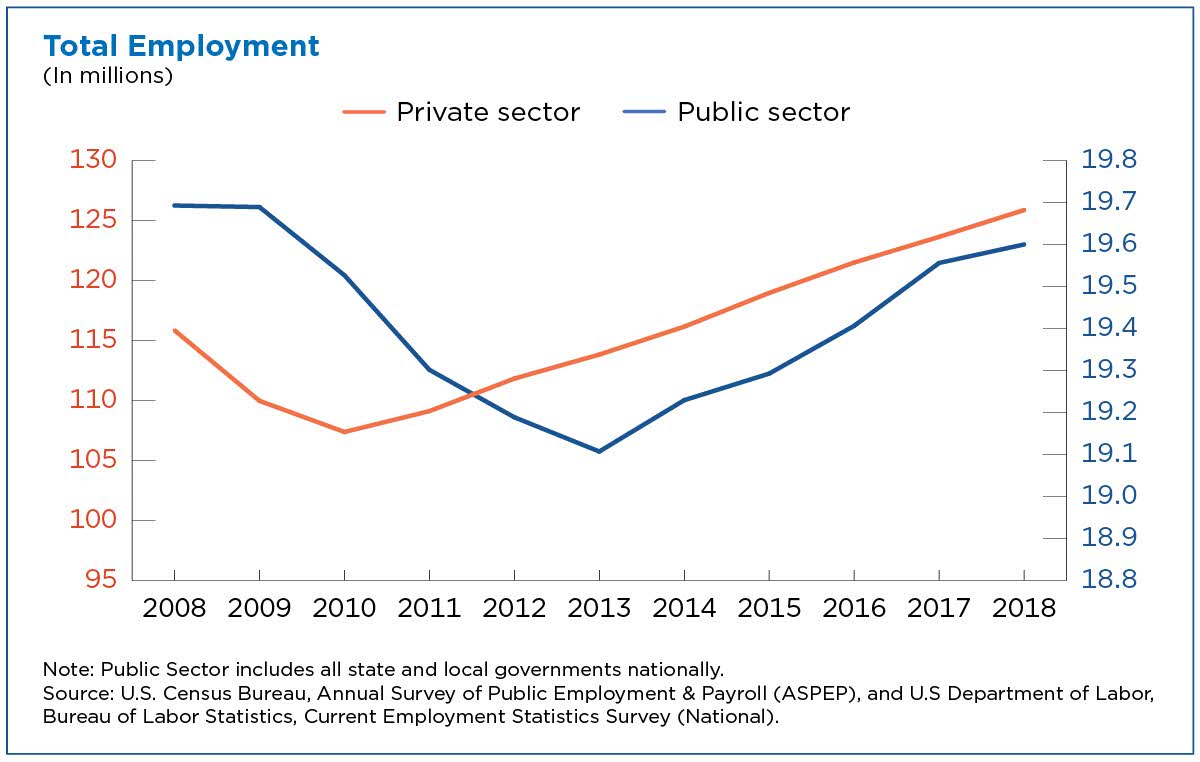Private Industry Hit Harder but Bounced Back Faster
Since the United States suffered an economic downturn more than 10 years ago, employment in the public sector has never fully bounced back.
The public sector took less of a hit than private industry but belt-tightening by state and local governments has not loosened enough to return to pre-recession employment levels.
Government tends to react more slowly than private industry to economic shifts. The decline in employment in the public sector began later and lasted longer than in the private sector.
What Happened?
From March 2008 to March 2018, the number of public sector jobs declined by 93,000 to 19.6 million, a 0.5% decline, according to U.S. Census Bureau statistics from the Annual Survey of Public Employment & Payroll (ASPEP).
By contrast, private industry has rebounded in a big way even though it took a bigger hit during the recession. Employment in the private sector in 2018 reached a total of 125.9 million jobs, according to the Bureau of Labor Statistics. Since 2008 (115.8 million jobs), the private sector has grown almost 8.65%, adding over 10 million jobs in spite of the downturn during that same 10-year period.
Government tends to react more slowly than private industry to economic shifts. The decline in employment in the public sector began later and lasted longer than in the private sector.
While the private sector was already stalled in 2008 and in decline in 2009, the public sector simply leveled off in 2009 and the decline in public employment was not seen until 2010.
Although employment in the public sector did not decline as much overall as employment in private industry, the rebound of the public sector is taking longer than it did for the private sector.
By March 2014, the private sector had already regained and surpassed the level of employment it had in the same month in 2008. As of March 2018, state and local governments still had not fully regained 2008 employment levels.
Government Services Hit the Hardest
During the period of decline, several areas experienced great impact in their level of government employment. Overall, state and local governments declined 3% from 2008 to 2013, losing more than 585,000 employees.
Elementary and secondary education saw the largest decrease by far in number of public employees, resulting in a 3.5% loss, nearly 279,000 employees, or almost half of all government jobs lost during this period. This was followed by a loss in law enforcement (down 5.7%, 58,000 jobs) and highways (down 8.8%, 50,000 jobs).
Growth Since the Turnaround
Since the decline ended, several areas have grown, though not as significantly as they may have declined previously. Overall, state and local governments increased 2.6% from 2013 to 2018, adding almost 500,000 employees, a bit shy of the number lost during the period of decline.
Elementary and secondary education also experienced the largest increase, adding 165,000 employees, or 2.2%. This is still a net loss of 114,000 overall from 2008 to 2018. This was followed by an increase in higher education (up 2.9%, 91,000 jobs) and hospitals (up 6.9%, 72,000 jobs).
Learn more about state and local public sector employees and the services they provide by viewing data from the Annual Survey of Public Employment & Payroll (ASPEP). This survey provides annual statistics on the number of state and local government civilian employees and their gross payrolls for the month of March.
The U.S. Congress, federal agencies, state and local governments, educational and research organizations, and the general public employ these results.
Subscribe
Our email newsletter is sent out on the day we publish a story. Get an alert directly in your inbox to read, share and blog about our newest stories.
Contact our Public Information Office for media inquiries or interviews.
-
Income and Poverty2018 U.S. Median Household Income Was $63,179, No Big Change From 2017September 10, 2019U.S. Census Bureau released 2018 income, poverty and health insurance statistics today. Survey redesigns make comparing statistics from prior years challenging.
-
PopulationGaps in the Wealth of Americans by Household TypeAugust 27, 2019The U.S. Census Bureau offers a new look at household wealth. U.S. households with higher wealth have equity in their homes and retirement accounts.
-
PopulationAre Women Really Opting Out of Work After They Have Babies?August 19, 2019More than 80% of highly educated women who had a baby in the last 12 months were in the labor force, compared to about half of women with a high school degree.
-
EmploymentThe Stories Behind Census Numbers in 2025December 22, 2025A year-end review of America Counts stories on everything from families and housing to business and income.
-
Families and Living ArrangementsMore First-Time Moms Live With an Unmarried PartnerDecember 16, 2025About a quarter of all first-time mothers were cohabiting at the time of childbirth in the early 2020s. College-educated moms were more likely to be married.
-
Business and EconomyState Governments Parlay Sports Betting Into Tax WindfallDecember 10, 2025Total state-level sports betting tax revenues has increased 382% since the third quarter of 2021, when data collection began.
-
EmploymentU.S. Workforce is Aging, Especially in Some FirmsDecember 02, 2025Firms in sectors like utilities and manufacturing and states like Maine are more likely to have a high share of workers over age 55.





